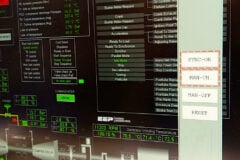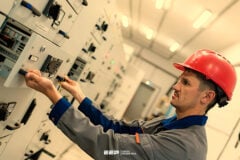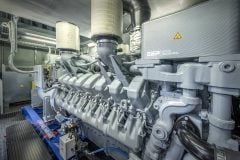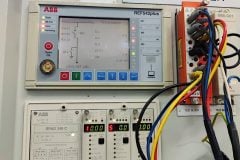Switchyard design
This article deals with switchyard design and it’s divided into two parts in which switchyard design considerations are discussed in the first part and the other part presents a case study of a 33/220 kV transmission switchyard. This article discusses different switchyard design considerations ranging from location to voltage, general layout.

Also, switchyard component sizing is presented along with the control and protection schemes implemented.
- Introduction
- Switchyard Design Considerations:
- Switchyard Components:
- Switchyard Control and Protection
1. Introduction
An electrical substation is a part of an electricity generation, transmission, and distribution system where voltage is transformed from high to low or in reverse using transformers. It also serves as a point of connection between various power system elements such as transmission lines, transformers, generators, and loads.
To allow for flexibility in connecting the elements, circuit breakers are used as high power switches.
An air-insulated substation (AIS), shown in Figure 1, is one where the main circuit potential is insulated from the ground by air using porcelain or composite insulators and/or bushings.
AIS is fully composed of air-insulated technology components such as circuit breakers, disconnecting switches (disconnectors), surge arrestors, instrument transformers, power transformers, capacitors, bus bars, and so on, and the components are connected by stranded flexible conductors, tubes, or buried power cables.
AIS is the most common type of substation, accounting for more than 70% of substations all over the world.
Figure 1 – Switchyard, air-insulated substation (AIS)


Switchgear consists of electrical disconnect switches such as fuses or circuit breakers, which are used to control protect and isolate the electrical equipment in case of fault conditions. Switchgears are devices that are used for the switching, protection, and controlling of an electrical circuit.
But switchyard is entirely different from it, maybe switchgear can be a piece of equipment in a switchyard, the transmission of the power which is generated in a power plant is done with the help of a switchyard it acts as a junction where the power transmission takes place. Switchyard can secure the power plant and can help in the transmission of power.
The switchyard operations depend on a safe and reliable power system. Each switchyard system design, whether new or an expansion to an existing system, must be analyzed to ensure that it is safe, reliable, meets the present objective and permits expansion for future needs.
Go back to the Contents Table ↑
2. Switchyard Design Considerations
The switchyard planning and design must include several considerations at the initial and planning or design stage.
2.1. Switchyard Location
Special consideration needs to be given to the location to achieve the optimal compromise between the line entry to the site and the switchyard.
The main factors that must be considered in the selection of the site for the construction of a switchyard are:
- Availability of access for the incoming transmission or sub-transmission lines and the distribution and communication systems circuits within the switchyard.
- Facilities for the transport of heavy equipment to the site.
- Environmental impacts of the site related to its appearance, noise, or electrical interference or its impact on other facilities.
- Conditions of the ground, its facility of drainage, soil resistivity, and its load-bearing capability.
- Cost of excavations and earthwork.
- Governmental or municipal restrictions at the site.
- General topographical considerations, including seismic levels and the risk of flooding and the proximity to marshy.
- Total cost, including the provision of distribution circuits to the plant and the required control and communication facilities.
Go back to the Contents Table ↑
2.2. Basic Information
Before beginning the design of a switchyard, it is necessary to obtain information on which the design will be based. One set of information required will concern the system to which the switchyard will be connected, such as the levels of active and reactive power available, the voltage regulation, the system short-circuit levels, the lightning risk, etc.
Other information includes the climatic data of the site, the seismic risk levels, the altitude, and the environmental requirements that must be taken into account in the design of the facilities.
Membership Upgrade Required
This content is not available in your premium membership plan. Please upgrade your plan in order to access this content. You can choose an annually based Basic, Pro, or Enterprise membership plan. Subscribe and enjoy studying specialized technical articles, online video courses, electrical engineering guides, and papers.
With EEP’s premium membership, you get additional essence that enhances your knowledge and experience in low- medium- and high-voltage engineering fields.
Black Friday Deal 💥 – Save 20% on Pro Plan with code BLACKFRIDAY
Copyright Notice
This technical article is protected by U.S. and international copyright laws. Reproduction and distribution of PDF version of this technical article to websites such as Linkedin, Scribd, Facebook and others without written permission of the sponsor is illegal and strictly prohibited.© EEP-Electrical Engineering Portal.
Related electrical guides & articles
Premium Membership
Salem Alshahrani
Electrical engineer (BEE & Meng). Specialized in substation design, especially in LV/MV switchgears and transformers. Passionate in power system planning, analysis, and stability studies.Profile: Salem Alshahrani










